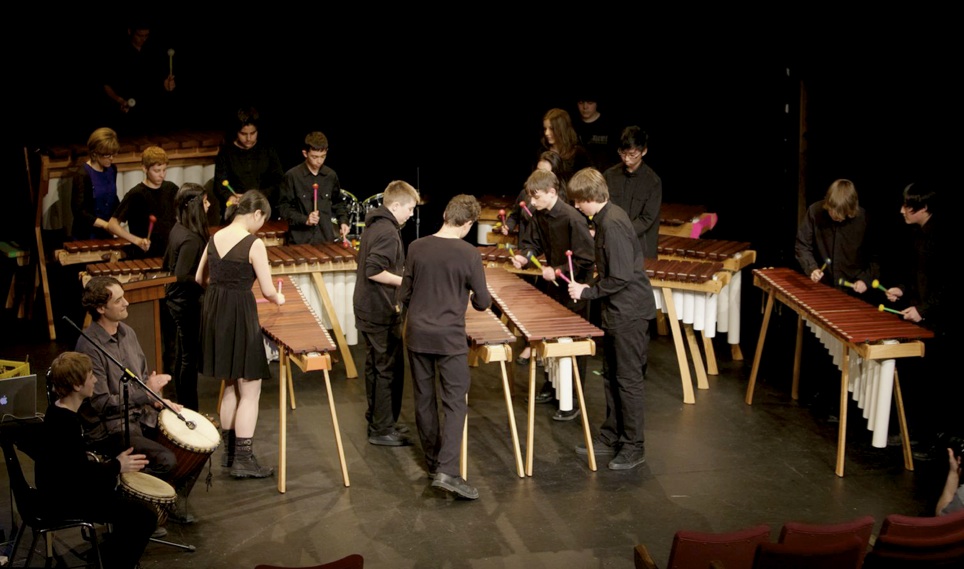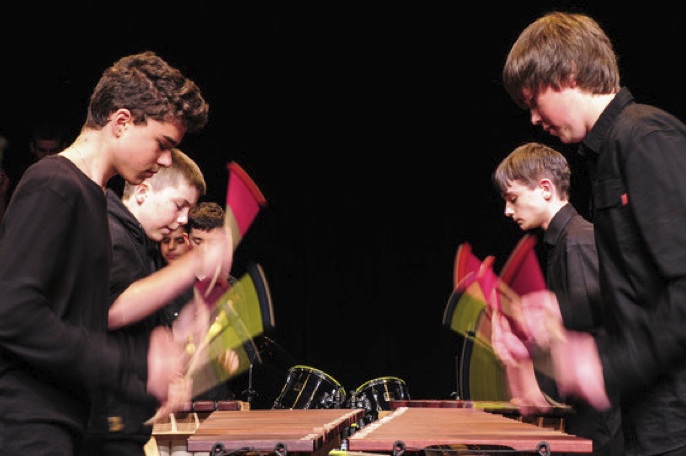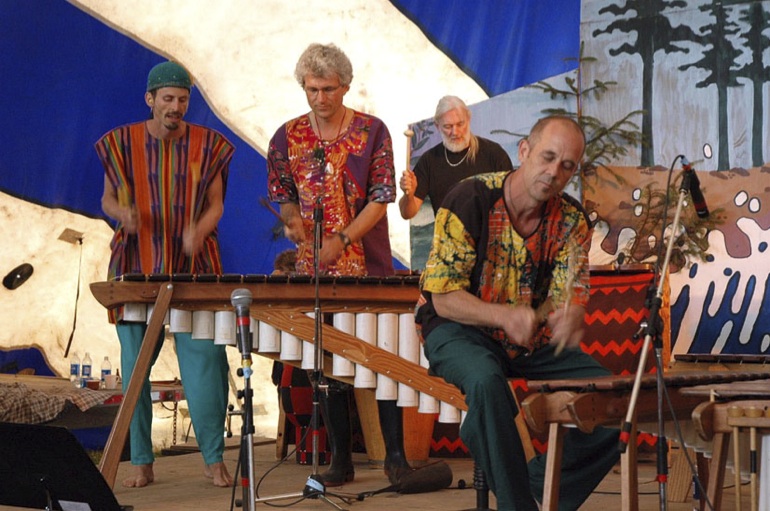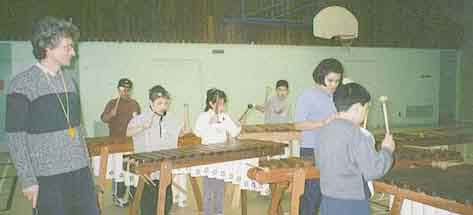 |
Marimba Magic 1437 Taunton Street, Victoria, B.C. Canada Phone: (250) 370-0739 E-mail: sales@marimbamagic.com |
Community, connection and empowermentthrough melodic percussion music
Playing together, speaking without words through sounds and movement; joyful, ecstatic, playful, transformative, Marimbas engage students in a powerful way to realize and express their passion and creativity. Marimba music inspires group cooperation, artistry, and self expression. 'Kids say "I feel like I am part of a team where everybody is important." ' (Paul Nichols, teacher at Charles Dickens School, Vancouver, BC) For teachers and students...
Members of the Brockton World Music Ensemble in concert What Teachers Say...(Brockton School World Music Program website) There are five Zimbabwean Marimba Ensembles in the World Music Program at Brockton School. These ensembles perform a diverse range of repertoire including traditional Shona tunes from Zimbabwe, newly composed Zimbabwean songs, arrangements of Western popular songs and student- driven compositions and arrangements. Our audiences have consistently commented on the high energy, engaging performances from each ensemble and have described our sound as "vital", "vibrant", "energetic", "warm", and "friendly". The North Shore News reported that the World Music Program Marimba Ensemble "is developing into a force to be reckoned with...The sound created by these traditional wooden African marimbas is almost otherworldly!" The instruments used by the WMP students were hand made on Vancouver Island by Rick Palmer whose skill in making these wonderful instruments is unmatched. He creates them from a variety of woods including Padauk (West African hardwood), Mahogany, Wenge and Western Yew." (Paul Nichols: music teacher, Charles Dickens School) "The impact statements from kids are unbelievable... Like kids talking about like they practically feel omnipotent almost when they do performances. The way they describe how they feel from performing, how they describe the sound and they talk about how much they love the sound of the instruments and they like working together to make the sound. And kids say I feel like I am part of a team where everybody is important. There is pretty amazing stuff in it. They are very successful instruments. This is one of the reasons we are doing the video. We need to get people to know how successful they are... The kids totally love them. "They are extraordinary successful instruments. You making the instruments is very important for us. There is a real need for more sets. I would like to see 5 more sets in Vancouver alone." Origins of the instruments and the music'Marimba' literally means voice of wood. Both percussive and melodic, wooden bars are struck with mallets to produce beautiful sounds. Each bar has its own note. A combination of bars is arranged to create between 1 and 3 octaves. Played sitting or standing, marimbas are kinesthetic instruments that involve lots of upper body movement. In short, they are fun to play! This type of instrument originated in Zimbabwe, in Africa. The instrument is capable of playing a wide range of musical styles like jazz, modern, etc. Traditionally, the music ranges from complex fast driving polyrhythms to slow trance-like pieces. Some characteristics of traditional Zimbabwean music include call and response form, interlocking melodies that repeat in circular fashion, double metric patterns and rhythmic cross patterns played by shakers and drums. The music is highly infectious, joyous, upbeat, and wonderful to dance to! In the Fall of 1968, Abraham Dumisani (Dumi) Maraire, was hired by the University of Washington in Seattle as an Artist in Residence to teach this music. Very quickly, the music of Zimbabwe became a hit in the University's music department and all around Seattle. Subsequently during the '70's, '80's and '90's, Dumi and his bands created excitement by performing and teaching this music up and down the West Coast. A ripple effect was created when many of Dumi's students began teaching this music to others. From its inception in Seattle in the early 1970's, it has spread all over North America. Many people can be found playing marimba music in Australia, New Zealand, Europe, Scandinavia and Japan.
Links
'Residency' Classes (Marimbas are supplied.)The intention of holding a series of classes is to enable students to learn a complete piece and then perform it for their school! Elementary and secondary students will be playing traditional Zimbabwean music adapted for their skill level.
Organizing a Class Series Is Easy! I suggest a group of students receive 8 classes over a 3 to 4 week
period depending upon your particular school's allocation of time. The
following example can be used to illustrate how the series could work
for you: A school has 3 groups of grade 6 and 7's currently taking music
twice a week. Using their present schedule, the 3 groups could take
consecutive classes in a multipurpose room or gym where the instruments
could be left set up for the 3 classes. Class time could be 40 min to
1 hr 15 min. Each week there would be a total of 6 classes taught, (2
classes per group), giving each group 8 classes over 4 weeks. Each group
could learn a different piece to perform!
An ideal class size has between 10 and 15 students, however, music
classes will accommodate up to 30 students. (There may be switching
involved where half the class learns at a time.)
One thing that makes an artist in residence program very rewarding
for the kids is when their music teacher gets involved by attending
a workshop with the artist prior to the residency itself to learn parts
of the pieces that will be taught. (A pro-development day works great.)
At Cook Elementary, Eric Hartman did just that, introducing his music
students to the pieces using some orff xylophones he had access to.
He also played a significant role during the residency classes by assisting
and also by helping the kids practice after the classes. His students
were able to learn 3 pieces and perform them at the end of the residency!
PricingArtist-in-Residence pricing is based on $75/hour (Canadian). Accommodation, meals and travel add $100/day. Expenses are shared among schools if more than one school is involved. Envision A Marimba Ensemble In Your School! A marimba building project for students within their woodworking / science / art courses can be part of an artist in residence program and could supply your school with instruments for ensemble playing. By first studying the science of sound applied to marimbas and then making an instrument as a combined woodworking / art project, students will learn that science, technical skill, and art are part of the craft of an instrument builder. This course is taught to groups with a demonstration and practical lesson of each phase of the building process followed by students completing sequential assignments till the instruments are completed. The course follows the booklet on marimba building written by Mr. Palmer which will be available through the B.C. Teachers Federation. Please contact me for further details. |
| Home | The Music | Learn to Play | How to Order | Marimba Building Workshops | Rick's Biography | School Programs | About Marimbas | Hand-made Marimbas | Marimba Magic | Contact Us | Related Sites |



 The educational goals of any school music program are to provide exposure and opportunity for all kids, independent of expensive private lessons. Music is historically and culturally revered around the world as an essential part of community life.
The educational goals of any school music program are to provide exposure and opportunity for all kids, independent of expensive private lessons. Music is historically and culturally revered around the world as an essential part of community life. 

